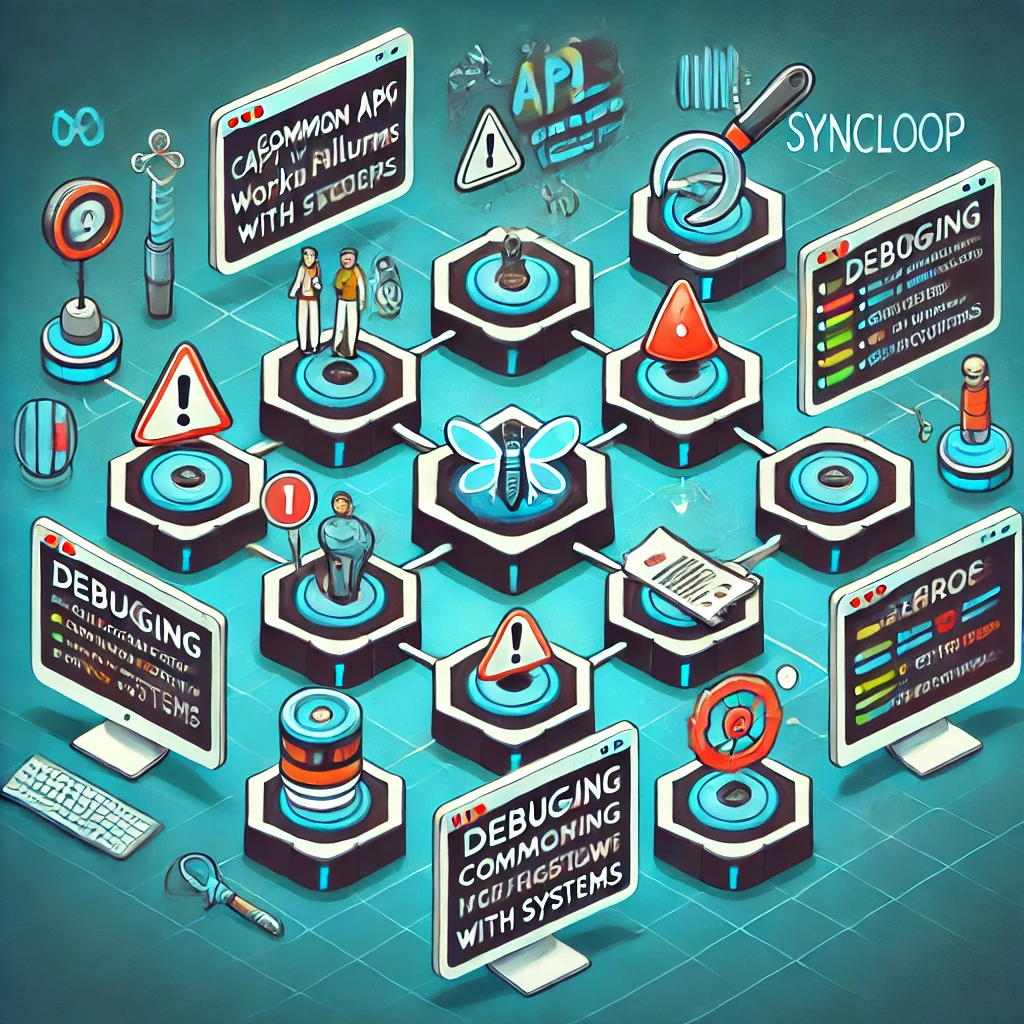Debugging Common API Workflow Failures in Distributed Systems with Syncloop

Syncloop provides a comprehensive toolkit for monitoring, diagnosing, and resolving API workflow issues in distributed systems. This blog explores common API workflow failures, how Syncloop helps in debugging, and best practices for maintaining robust workflows.
Common API Workflow Failures in Distributed Systems
- Latency Issues Increased response times due to network delays or overloaded services.
- Dependency Failures Downstream service unavailability affecting upstream workflows.
- Data Inconsistencies Conflicts arising from simultaneous updates or delayed synchronization.
- Rate Limit Exceedance Breaches of API quotas due to unexpected traffic spikes.
- Authentication Failures Token expiration or incorrect credentials disrupting secure API calls.
- Timeouts Services failing to respond within the expected timeframe, causing cascading failures.
How Syncloop Simplifies Debugging API Workflow Failures
Syncloop equips developers with tools to address workflow issues effectively:
- Real-Time Monitoring Visualize API traffic, response times, and error rates for quick diagnostics.
- Detailed Logs Capture granular logs of API requests, responses, and errors.
- Workflow Visualization Map dependencies and execution flows to identify bottlenecks.
- Error Categorization Classify errors by type, severity, and affected services for prioritized resolution.
- Retry Mechanisms Automate retries with exponential backoff for transient errors.
- Custom Alerts Configure notifications for critical failures, such as timeout breaches or high error rates.
Steps to Debug Workflow Failures with Syncloop
Step 1: Monitor Workflows in Real Time
Enable Syncloop’s real-time monitoring tools to:
- Track latency, error rates, and throughput for each API.
- Identify performance bottlenecks or failing services.
- Pinpoint periods of unusual activity or traffic spikes.
Step 2: Analyze Logs
Use Syncloop’s logging tools to investigate:
- Request and response details, including payloads and headers.
- Error messages and status codes.
- Correlation IDs for tracing across services.
Step 3: Visualize Dependencies
Leverage Syncloop’s workflow visualization to map:
- API dependencies and call hierarchies.
- Bottlenecks caused by slow or failing services.
- Cascading failures affecting multiple workflows.
Step 4: Implement Error Handling
Configure workflows in Syncloop to:
- Retry failed API calls with exponential backoff.
- Implement fallbacks for critical services.
- Use circuit breakers to prevent cascading failures.
Step 5: Optimize Workflows
Based on insights, optimize workflows by:
- Reducing redundant API calls.
- Adjusting timeouts and retries for better fault tolerance.
- Improving load distribution across services.
Step 6: Test and Validate
Simulate failure scenarios using Syncloop’s testing environment. Validate:
- Error handling strategies.
- Workflow resilience under load.
- Recovery mechanisms for critical services.
Best Practices for Managing API Workflows in Distributed Systems
- Design for Resilience Use retries, fallbacks, and circuit breakers to handle failures gracefully.
- Monitor Continuously Track workflow performance and error trends to identify issues proactively.
- Optimize for Latency Reduce response times by optimizing service dependencies and data pipelines.
- Use Idempotent APIs Design APIs to handle repeated requests without adverse effects.
- Document Dependencies Maintain clear documentation of API dependencies and workflows for troubleshooting.
Example Use Case: E-Commerce Platform
An e-commerce platform leverages Syncloop to manage API workflows for order processing:
- Real-Time Monitoring: Tracks order API performance during flash sales.
- Dependency Mapping: Identifies bottlenecks in payment and inventory services.
- Error Handling: Implements retries for failed payment transactions.
- Alerts: Notifies teams of timeout errors in high-traffic periods.
- Optimization: Adjusts timeouts and circuit breakers for better fault tolerance.
Benefits of Using Syncloop for Workflow Debugging
- Faster Resolution: Quickly identify and resolve workflow issues with detailed insights.
- Improved Reliability: Build fault-tolerant workflows that handle failures gracefully.
- Enhanced Scalability: Support growing workloads without performance degradation.
- Actionable Insights: Gain visibility into workflow performance for optimization.
- Streamlined Management: Simplify monitoring and debugging in complex distributed systems.
The Future of API Workflow Management
As distributed systems become increasingly complex, managing API workflows will require advanced tools and strategies. Syncloop empowers developers with the capabilities to build, monitor, and optimize robust workflows, ensuring reliability and scalability in any environment.
Image Description
A conceptual illustration showcasing Syncloop’s tools for debugging API workflows in distributed systems, featuring real-time monitoring, error handling, and dependency mapping. The image highlights seamless diagnostics and optimization for complex architectures.
Back to Blogs